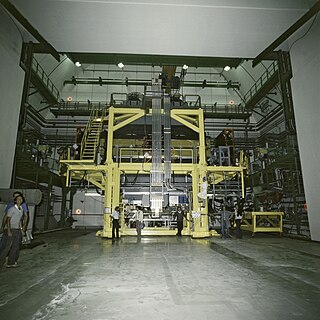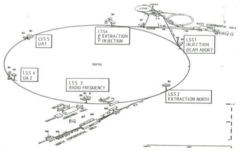
Carlo Rubbia is an Italian particle physicist and inventor who shared the Nobel Prize in Physics in 1984 with Simon van der Meer for work leading to the discovery of the W and Z particles at CERN.

The antiproton,
p
, is the antiparticle of the proton. Antiprotons are stable, but they are typically short-lived, since any collision with a proton will cause both particles to be annihilated in a burst of energy.

The Large Electron–Positron Collider (LEP) was one of the largest particle accelerators ever constructed. It was built at CERN, a multi-national centre for research in nuclear and particle physics near Geneva, Switzerland.

The Underground Area 2 (UA2) experiment was a high-energy physics experiment at the Proton-Antiproton Collider — a modification of the Super Proton Synchrotron (SPS) — at CERN. The experiment ran from 1981 until 1990, and its main objective was to discover the W and Z bosons. UA2, together with the UA1 experiment, succeeded in discovering these particles in 1983, leading to the 1984 Nobel Prize in Physics being awarded to Carlo Rubbia and Simon van der Meer. The UA2 experiment also observed the first evidence for jet production in hadron collisions in 1981, and was involved in the searches of the top quark and of supersymmetric particles. Pierre Darriulat was the spokesperson of UA2 from 1981 to 1986, followed by Luigi Di Lella from 1986 to 1990.

The UA1 experiment was a high-energy physics experiment that ran at CERN's Proton-Antiproton Collider, a modification of the one-beam Super Proton Synchrotron (SPS). The data was recorded between 1981 and 1990. The joint discovery of the W and Z bosons by this experiment and the UA2 experiment in 1983 led to the Nobel Prize for physics being awarded to Carlo Rubbia and Simon van der Meer in 1984. Peter Kalmus and John Dowell, from the UK groups working on the project, were jointly awarded the 1988 Rutherford Medal and Prize from the Institute of Physics for their outstanding roles in the discovery of the W and Z particles.
In physics, the pomeron is a Regge trajectory — a family of particles with increasing spin — postulated in 1961 to explain the slowly rising cross section of hadronic collisions at high energies. It is named after Isaak Pomeranchuk.

The Super Proton Synchrotron (SPS) is a particle accelerator of the synchrotron type at CERN. It is housed in a circular tunnel, 6.9 kilometres (4.3 mi) in circumference, straddling the border of France and Switzerland near Geneva, Switzerland.

The ISR was a particle accelerator at CERN. It was the world's first hadron collider, and ran from 1971 to 1984, with a maximum center of mass energy of 62 GeV. From its initial startup, the collider itself had the capability to produce particles like the J/ψ and the upsilon, as well as observable jet structure; however, the particle detector experiments were not configured to observe events with large momentum transverse to the beamline, leaving these discoveries to be made at other experiments in the mid-1970s. Nevertheless, the construction of the ISR involved many advances in accelerator physics, including the first use of stochastic cooling, and it held the record for luminosity at a hadron collider until surpassed by the Tevatron in 2004.
The Roman pot is the name of a technique used in accelerator physics. Named after its implementation by the CERN-Rome collaboration in the early 1970s, it is an important tool to measure the total cross section of two particle beams in a collider. They are called pots because the detectors are housed in cylindrical vessels. The first generation of Roman pots was purpose-built by the CERN Central Workshops and used in the measurement of the total cross-section of proton-proton inter-actions in the ISR.
In particle physics, the odderon corresponds to an elusive family of odd-gluon states, dominated by a three-gluon state. When protons collide elastically with protons or with anti-protons at high energies, even or odd numbers of gluons are exchanged. Exchanging an even number of gluons is a crossing-even part of elastic proton–proton and proton–antiproton scattering, while odderon exchange, i.e. exchange of odd number of gluons, corresponds to a crossing-odd term in the elastic scattering amplitude. It took about 48 years to find a definite signal of odderon exchange.

The Antiproton Accumulator (AA) was an infrastructure connected to the Proton–Antiproton Collider – a modification of the Super Proton Synchrotron (SPS) – at CERN. The AA was built in 1979 and 1980, for the production and accumulation of antiprotons. In the SppS the antiprotons were made to collide with protons, achieving collisions at a center of mass energy of app. 540 GeV. Several experiments recorded data from the collisions, most notably the UA1 and UA2 experiment, where the W and Z bosons were discovered in 1983.

Luigi Di Lella is an Italian experimental particle physicist. He has been a staff member at CERN for over 40 years, and has played an important role in major experiments at CERN such as CAST and UA2. From 1986 to 1990 he acted as spokesperson for the UA2 Collaboration, which, together with the UA1 Collaboration, discovered the W and Z bosons in 1983.

Pierre Darriulat is a French experimental particle physicist. As staff member at CERN, he contributed in several prestigious experiments. He was the spokesperson of the UA2 collaboration from 1981 to 1986, during which time the UA2 collaboration, together with the UA1 collaboration, discovered the W and Z bosons in 1983.

The Super Proton–Antiproton Synchrotron was a particle accelerator that operated at CERN from 1981 to 1991. To operate as a proton-antiproton collider the Super Proton Synchrotron (SPS) underwent substantial modifications, altering it from a one beam synchrotron to a two-beam collider. The main experiments at the accelerator were UA1 and UA2, where the W and Z bosons were discovered in 1983. Carlo Rubbia and Simon van der Meer received the 1984 Nobel Prize in Physics for their contributions to the SppS-project, which led to the discovery of the W and Z bosons. Other experiments conducted at the SppS were UA4, UA5 and UA8.

The UA5 experiment was the first experiment conducted at the Proton-Antiproton Collider, a collider using the infrastructure of the Super Proton Synchrotron (SPS). The experiment was approved in February 1979, as a collaboration between CERN and the universities of Bonn, Brussels, Cambridge and Stockholm. The spokesperson of the UA5 collaboration was John Rushbrooke.

UA8 experiment was a high-energy physics experiment at the Proton-Antiproton Collider at CERN. The proposal for the experiment was done by physicists at the University of California, and it was approved in April 1985. Its spokesperson was Peter Schlein.

]

The Scattering and Neutrino Detector (SND) at the Large Hadron Collider (LHC), CERN, is an experiment built for the detection of the collider neutrinos. The primary goal of SND is to measure the p+p --> +X process and search for the feebly interacting particles. It will be operational from 2022, during the LHC-Run 3 (2022-2024). SND will be installed in an empty tunnel- TI18 that links the LHC and Super Proton Synchrotron, 480m away from the ATLAS experiment interaction point in the fast forward region and along the beam collision axis.

The Underground Area 6 (UA6), also referred to as PHOTONS, experiment was a high-energy physics experiment at the Proton-Antiproton Collider, a modification of the Super Proton Synchrotron (SPS), at CERN. The experiment ran from 1984 to 1990, with the purpose of studying inclusive electromagnetic final states and lambda production in proton-antiproton and proton-proton interactions. Towards the end of its run it focused more on direct-photon and J/ψ production. The experiment is complementary to the UA1, UA2 and CDF experiments.

The Underground Area 7 (UA7) experiment was a high-energy physics experiment at the Proton-Antiproton Collider, a modification of the Super Proton Synchrotron (SPS), at CERN. The purpose of the experiment was to measure the invariant cross section of photons and neutral pions (π0) emitted close to zero degrees, by using silicon shower detectors. The experiment data taking ran from 1985 to 1986, and the final analysis was completed in 1996.














